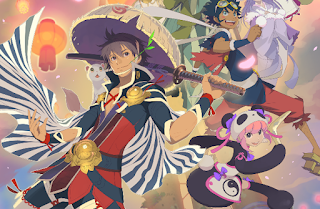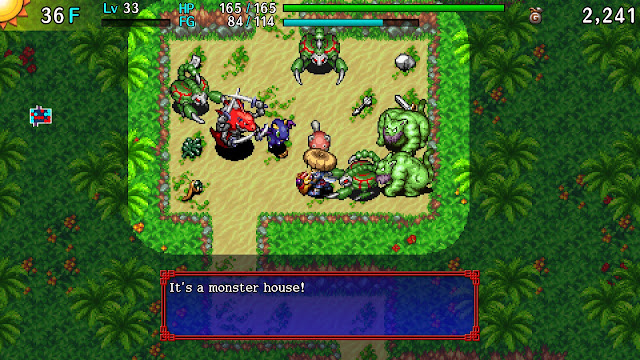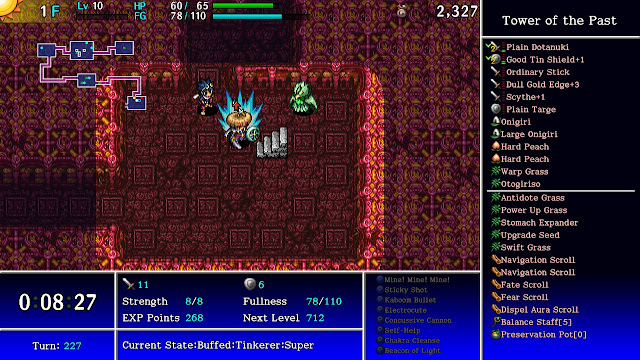It is appropriate to make the core motif of a Shiren the Wanderer game – a genuine pioneer in the now saturated roguelike genre – that of fate and fortune. The roguelike, after all, depends entirely on the metaphoric roll of the dice, to determine everything from the dungeon layouts to the monsters that you’ll fight, and the thing that keeps you playing is, typically, the promise of finding amazing loot in the unknown. It was not surprising to me in the slightest that PlayStation Vita darling, Shiren the Wanderer: The Tower of Fortune and the Dice of Fate, despite being modest of appearance and a most traditional Mystery Dungeon roguelike, would continue to pull a crowd. That’s why we now have it on Nintendo Switch, and while the updates to it are mild from that Vita release, the core game is well worth a replay.
Shiren the Wanderer, way back when now, was the series that really established the Mystery Dungeon formula, and as such, it deserves the credit for all the swears and curses that player have directed at it since. As a twist on the procedural generation of the all-time classic, Rogue, Shiren the Wanderer delighted in knocking players out, and then forcing them to start again at ground zero, at level 1, with no money, and all the loot they had just acquired taken away from them. There was a limited ability to save particularly precious items at certain intervals, but once you’d stashed away a particularly powerful sword or shield, you would become incredibly hesitant to actually use it, because to pull it out of storage was to risk losing it the moment you came across a particularly nasty monster.
If you’ve not played a Shiren title before, all of this probably seems drastically unintuitive and punitive. In fairness, for anyone who hasn’t become enamoured to the formula (Stockholm Syndrome-style) it likely is, since more modern Mystery Dungeon games have found ways to mitigate against the risk of complete devastation if a dungeon crawl goes awry. The Pokemon Mystery Dungeon games, for example, keep the dungeons themselves relatively brief in length so that the impact of a long delve that results in a knock out is lessened. Chocobo Mystery Dungeon, meanwhile, lets you keep your experience levels and equipment on a KO, even if it strips away the cash you’d accumulated and items. Shiren the Wanderer avoids capitulating to such “softening,” and it is the real deal, with brutal difficulty curves and all. There’s an audience for that, though, and while it might feel like it should be a small one, a lot of people do get drawn into the web of Mystery Dungeons.
Another benefit, as far as the streaming goes, is that Shiren the Wanderer doesn’t beat around the bush. It’s a game of snappy pace and few words. As I noted in my review of the game on PlayStation Vita, it’s actually quite effective with the words that it does use, and represents the Japanese philosophy, aesthetic, and storytelling tradition better than people tend to give it credit for, but streamers don’t need to worry about hours of front-end tutorials and cut scenes before they can get to the audience engagement gold. This is a side note, but I find it quite charming that Spike Chunsoft has bookended the year like this. Earlier in the year, there was Katana Kami which, while being darker and gorier visually, was a roguelike take on the Hyakki Yagyō – Night Parade of One Hundred Demons – storytelling tradition in Japanese folklore. Shiren the Wanderer, while bright and colourful, has ended the year in the same way. Spike Chunsoft is a company that has a long, proud heritage of bringing this authentically Japanese folklore tradition to videogames, and if there’s any single way to describe this Shiren he wanderer, it’s just that. It’s a work of heritage, and you can feel that as you play.
Ultimately, Shiren is a game about failure, in the same way that FromSoftware’s Souls games would become, many years after the first Shiren landed on the scene. It’s a game about learning to balance risk with safety, learning to “read” the levels by making mistakes in them, and learning from enemies by falling to them. Though each enemy only has a few different attacks and very simple AI, to succeed at Shiren you need to develop an intuitive understanding of just how many times you’ll need to attack an enemy to defeat it, just how to move around to limit your exposure to any special attacks, and when you’re at the right experience level to move to the next dungeon floor. You’ll often find the staircase to the next floor quickly on any delve, but to immediately rush up it will often be a mistake as you’ll be under-levelled for the threats above, and there’s no way to backtrack down levels. It’s only through having the patience to replay levels and learn them to the point of instinct that you’ll make progress. But you will, indeed, start to make progress and, even when you’re in the same position on each re-start, you’ll start to find that what was once challenging has become much easier.
Shiren the Wanderer: The Tower of Fortune and the Dice of Fate was excellent on PlayStation Vita, and it remains excellent on Nintendo Switch. There are a lot of roguelikes available on this console at this point, but there’s something about the classical elegance and adherence to genre tradition that makes Shiren the Wanderer appealing. It’s a little like how some people still love the sound and experience of vinyl records, really. You’re not going to be blown away by innovation with this game, but you may well find yourself in love with its sincerity and near-perfect refinement.










